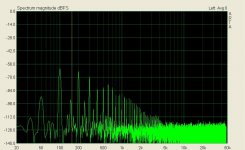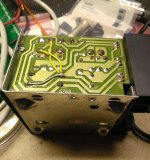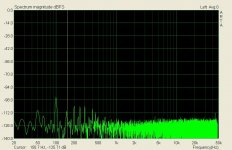well theres always lead pants, though that would seem to be ..erm...'counterproductive' 
sorry
OK look weve had a bit of fun here, but it really does seem like there is a LOT of irrationally extreme fears and misdirected treatment of this problem on the forum at the moment.
bare with me while I try to turn this into something positive.
not all companies are 'good people' and not all countries test everything for EMC thoroughly; (think ebay...) so there are problems in the increasingly RF saturated environment. in fact there is a good chance some of the problems people are attributing to SMPS and black magic digital error, are really just inadequate input filtering on overly wide bandwidth analogue design picking up, or being distorted by sidebands of broadcast (384khz dac with stacks of connected modules and aerials everywhere, connected to a high bandwidth analogue stage to cope with hires and no filter).
this can perhaps be coupled with less than perfect execution in layout and wiring/grounding to present as an illusive digital problem. since we have yet to be presented with a feasible problem to solve, how about tackling it somewhere less of a grey area?
we know some good ways to solve these problems, sorry guys but linear power supplies for your PC has got to be one of the least effective..... thats being generous
i'm wondering if this deserves a thread on how to deal with these problems effectively at the DAC. not everyone wants to do the fifo, which is a superb solution, so what about a thread in one of the forums (power supply or digital source/line level?) or maybe even a wiki if we can get the brains trust together, so that we can tackle these actual real problems with names and solutions, head on?
sorry
OK look weve had a bit of fun here, but it really does seem like there is a LOT of irrationally extreme fears and misdirected treatment of this problem on the forum at the moment.
bare with me while I try to turn this into something positive.
not all companies are 'good people' and not all countries test everything for EMC thoroughly; (think ebay...) so there are problems in the increasingly RF saturated environment. in fact there is a good chance some of the problems people are attributing to SMPS and black magic digital error, are really just inadequate input filtering on overly wide bandwidth analogue design picking up, or being distorted by sidebands of broadcast (384khz dac with stacks of connected modules and aerials everywhere, connected to a high bandwidth analogue stage to cope with hires and no filter).
this can perhaps be coupled with less than perfect execution in layout and wiring/grounding to present as an illusive digital problem. since we have yet to be presented with a feasible problem to solve, how about tackling it somewhere less of a grey area?
we know some good ways to solve these problems, sorry guys but linear power supplies for your PC has got to be one of the least effective..... thats being generous
i'm wondering if this deserves a thread on how to deal with these problems effectively at the DAC. not everyone wants to do the fifo, which is a superb solution, so what about a thread in one of the forums (power supply or digital source/line level?) or maybe even a wiki if we can get the brains trust together, so that we can tackle these actual real problems with names and solutions, head on?
Last edited:
what makes you think you have a cleaner ground plane? LDOs, which includes the 1084, generally have pretty crappy transient response and either way what has it got to do with the ground plane? the PC is still covered with little SMPS and the processors are still the same high bandwidth, fast switching, very transient load. all this still dumps into the ground plane, just like before.
You are discounting linear supplies too hastily.
The main benefit is to remove the pollution that SMPTS produces to the rest of the equipment, particularly to the ground.
This topic is interesting, I started with the idea to go linear, and with time I changed my mind towards isolating* the critical analog equipment and leave the rest with the majority of the switching crap that is everywhere nowadays.
*yeah a few good old isolation transformers generously sized to diy or a line regeneator such as purepower to buy.
no, i'm really not
because of this
I think its more you dismissing SMPS too hastily, properly designed SMPS does not do that and it has advantages over linear, you think that would be OK with low noise scientific and medical equipment? this delusion that audio equipment is somehow more sensitive than anything else just wont die, its fallacy.
the best conceived linear will still leave the switching regulators all over the PC and the switching of the actual circuits doing their normal thing, switching away. just wall it off from your audio gear and isolate ground on anything connected to it and be done with it, even as you mention, just from being in the world we live in its bathed in HF noise
most of the linear supplies I see getting built for PCs are very rudimentary because of the high current, so its not like its anything state of the art. thats a walk in the lark for a good SMPS.
because of this
This topic is interesting, I started with the idea to go linear, and with time I changed my mind towards isolating* the critical analog equipment and leave the rest with the majority of the switching crap that is everywhere nowadays.
I think its more you dismissing SMPS too hastily, properly designed SMPS does not do that and it has advantages over linear, you think that would be OK with low noise scientific and medical equipment? this delusion that audio equipment is somehow more sensitive than anything else just wont die, its fallacy.
the best conceived linear will still leave the switching regulators all over the PC and the switching of the actual circuits doing their normal thing, switching away. just wall it off from your audio gear and isolate ground on anything connected to it and be done with it, even as you mention, just from being in the world we live in its bathed in HF noise
most of the linear supplies I see getting built for PCs are very rudimentary because of the high current, so its not like its anything state of the art. thats a walk in the lark for a good SMPS.
Last edited:
I think its more you dismissing SMPS too hastily, properly designed SMPS does not do that and it has advantages over linear, you think that would be OK with low noise scientific and medical equipment? this delusion that audio equipment is somehow more sensitive than anything else just wont die, its fallacy.
SMPS.
I use a smtp dc-dc PSU for my dedicated audio pc, but the issue is all the other devices powered by switching psu such as tv, blue-ray player and so on. I surely do not want to design a good psu for them!
sure, but whats that got to do with it? those are there whether you power with linear or not. thus my comment, wall it off and forget about it. IMO the best processes to get digital audio out of PCs involve galvanically isolating the PC from the analogue and then reclock it anyway, so why spend so much effort on the PC when its integrity is rendered pretty much moot.
Because galvanic isolation adds too much jitter.
you arent reading properly, galvanic isolation is before the synchronous reclocking stage but after fifo buffer, proven to work as designed with measurements the other day at 2ps or less output jitter after the flip-flops/clock buffers. everything before the dual clock board (with dual CCHD975 in my case) is walled off and the i2s reclocked with the new master clock, which is also the ESS clock
I can tell you now, you are not using anything DIY that is lower jitter, show something lower jitter (not a clock in isolation). you can get this sort of performance with integrated designs with single sources, I do not know of a USB source or MUX with i2s out at this level.
the key in what I wrote, galvanic isolation, THEN reclocking. thus the isolation adds a small amount of jitter, which is erased with the rest of it when the local master clock is installed. the fifo output that low jitter with WM8804 inputting over +/-150 peak to peak jitter from the spdif input.
Last edited:
While I have a bit of a go at people who claim that RF is getting into their system is it not because RF will not cause problems, most certainly it will. The best illustration of that is the GSM ring protocol, try leaving a GSM mobile phone near any poorly shielded sensitive equipment. My gripe is that people treat excluding RF from sensitive circuits as a difficult problem and avoid it then take extreme measures of dubious technical merit rather than tackle the real problem.
Electricity wants to form a circuit, RF is no different, the trick is to give the RF an easy path back to the origin while making the path to Audio system difficult. At radio frequencies stray capacitance and stray inductance form an appreciable part of the circuit and need to be taken into account. I cannot begin to give a lesson on how to do this, there are many books which cover the subject and to illustrate that it is quite achievable, that was the purpose of my waveguide comment. There are many examples of high power RF being used in close proximity to sensitive circuits with correct operation of the sensitive circuit.
Back to the PC, common mode noise from the ground rail is going to swamp most other sources of unwanted signal. Cheapo PC card manufacturers do not appear to understand isolated inputs and outputs or the bare minimum differential inputs and outputs so all the hash on the ground plane of the PCB ends up on the input and output ground of the PC card. A properly designed board will keep the noise off the signal.
Wrapping the shielded signal cables around suitable RF suppression ferrites will go a long way toward removing the higher frequencies from the common mode. USB will not help because the signal ground travels with the USB data. Ethernet has isolation as does optical fibre. Isolated analogue I/O is fairly common for industrial instrumentation as are differential signals. Electrical noise in an industrial environment can be quite extreme but the techniques mentioned have been proven effective in keeping the signals of interest reasonably clean.
A thought about jitter, google delta sigma A/D converter and consider that the recording studio might have used one of these. Jitter is not always a bad thing.
As for the ear being able to hear 200kHz, maybe but Audio D/A converters have a passive filter with a rolloff frequency of less than 22kHz to avoid aliasing.
Electricity wants to form a circuit, RF is no different, the trick is to give the RF an easy path back to the origin while making the path to Audio system difficult. At radio frequencies stray capacitance and stray inductance form an appreciable part of the circuit and need to be taken into account. I cannot begin to give a lesson on how to do this, there are many books which cover the subject and to illustrate that it is quite achievable, that was the purpose of my waveguide comment. There are many examples of high power RF being used in close proximity to sensitive circuits with correct operation of the sensitive circuit.
Back to the PC, common mode noise from the ground rail is going to swamp most other sources of unwanted signal. Cheapo PC card manufacturers do not appear to understand isolated inputs and outputs or the bare minimum differential inputs and outputs so all the hash on the ground plane of the PCB ends up on the input and output ground of the PC card. A properly designed board will keep the noise off the signal.
Wrapping the shielded signal cables around suitable RF suppression ferrites will go a long way toward removing the higher frequencies from the common mode. USB will not help because the signal ground travels with the USB data. Ethernet has isolation as does optical fibre. Isolated analogue I/O is fairly common for industrial instrumentation as are differential signals. Electrical noise in an industrial environment can be quite extreme but the techniques mentioned have been proven effective in keeping the signals of interest reasonably clean.
A thought about jitter, google delta sigma A/D converter and consider that the recording studio might have used one of these. Jitter is not always a bad thing.
As for the ear being able to hear 200kHz, maybe but Audio D/A converters have a passive filter with a rolloff frequency of less than 22kHz to avoid aliasing.
One of the best books (if not thee) is Henry Otts Electromagnetic Compatability Engineering, a must for anyone involved in electronic design, PCB layout, system building etc
http://www.hottconsultants.com/pdf_files/pcb_guide.pdf
My favorite:
http://www.hottconsultants.com/pdf_files/pcb_guide.pdf

http://www.hottconsultants.com/pdf_files/pcb_guide.pdf
My favorite:
http://www.hottconsultants.com/pdf_files/pcb_guide.pdf
Audio D/A converters have a passive filter with a rolloff frequency of less than 22kHz to avoid aliasing.
You sure about that? Even after the eighties?
Hi marce,
Yes, it is important.
15 years ago I returned to school and studied PCB design and EMC at the university. The latter opened a whole new world for me. Highly recommended!
Btw, not all supplies are equal even if the same, Linear/SMPS.
Recently I needed a +/-15V supply for a application. I found a linear Mascot stabilized +/- 15V 250mA in my storage. Perfect, or? Well, lets measure. Pic1, load 100mA - not so good! Opened it up and the PCB design were a disaster. Caps on stubs. Currents in tracks also used for reference.
Quick fix just to prove current design wrong. Cut two tracks and three wire jumpers pic2. Result: Pic3 explains it better than words. Of course, more to improve but that's the job for a new PCB.



Yes, it is important.
15 years ago I returned to school and studied PCB design and EMC at the university. The latter opened a whole new world for me. Highly recommended!
Btw, not all supplies are equal even if the same, Linear/SMPS.
Recently I needed a +/-15V supply for a application. I found a linear Mascot stabilized +/- 15V 250mA in my storage. Perfect, or? Well, lets measure. Pic1, load 100mA - not so good! Opened it up and the PCB design were a disaster. Caps on stubs. Currents in tracks also used for reference.
Quick fix just to prove current design wrong. Cut two tracks and three wire jumpers pic2. Result: Pic3 explains it better than words. Of course, more to improve but that's the job for a new PCB.



Last edited:
Yes A quick check to confirm just in case my memory was failing me.You sure about that? Even after the eighties?
There is no escaping Nyquist, over sampling just make it possible to get good results with a single pole filter on the D/A convertor, which has both a cost and a phase error reduction advantage.
Qusp, 843 pages including index
AKN, got to admit when called in to sort out a PCB thats failing EMC or just problematic, it is usually a SMPS that is layed out incorrectly, often by both dedicated PCB designers and engineers that lay there own boards out (often the worse layouts). This is a big problem even with reference designs, numerous application notes and design guides. I have discussed this with SMPS application engineers from the likes of TI and Linear, and it does seem to be a big problem, bad SMPS layout!!! I believe it is this that gives SMPS a bad name. Once where I worked we outsourced from a distant shore some SMPS,s, the samples were perfect, the container load that we recieved were so noisey we had to scrap all of them. Unlike linear PSU's SMPS;s are not forgiving of bad layout.
I do get frustated with bad layout of SMPS's because basicly the design and layout rules are simple.
AKN, got to admit when called in to sort out a PCB thats failing EMC or just problematic, it is usually a SMPS that is layed out incorrectly, often by both dedicated PCB designers and engineers that lay there own boards out (often the worse layouts). This is a big problem even with reference designs, numerous application notes and design guides. I have discussed this with SMPS application engineers from the likes of TI and Linear, and it does seem to be a big problem, bad SMPS layout!!! I believe it is this that gives SMPS a bad name. Once where I worked we outsourced from a distant shore some SMPS,s, the samples were perfect, the container load that we recieved were so noisey we had to scrap all of them. Unlike linear PSU's SMPS;s are not forgiving of bad layout.
I do get frustated with bad layout of SMPS's because basicly the design and layout rules are simple.
I can hardly waitQusp, 843 pages including index
On backorder with the mob in Aus so I think 4 or 5 weeks away from my eager hands
- Status
- This old topic is closed. If you want to reopen this topic, contact a moderator using the "Report Post" button.
- Home
- Amplifiers
- Power Supplies
- Linear power supply for pc